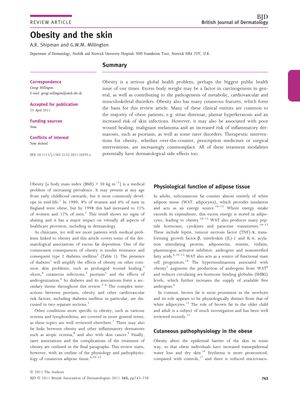Obesity and the Skin
September 2011
in “
British Journal of Dermatology
”
striae distensae plantar hyperkeratosis skin infections poor wound healing malignant melanoma inflammatory dermatoses psoriasis adipose tissue hormone production cytokine production insulin resistance type 2 diabetes mellitus hyperandrogenism vascular disorders ulceration atopic eczema skin cancer phototype I red hair stretch marks thickened skin on feet inflammatory skin conditions fat tissue type 2 diabetes high androgen levels blood vessel disorders skin ulcers eczema fair skin

TLDR Obesity is linked to various skin problems and may increase the risk of skin cancer.
The 2011 review article "Obesity and the skin" examines the relationship between obesity and various skin conditions. It explains that obesity, defined by a BMI greater than 30 kg/m², is associated with skin issues such as striae distensae, plantar hyperkeratosis, and an increased risk of skin infections, as well as poor wound healing and a higher risk of malignant melanoma and inflammatory dermatoses like psoriasis. The article discusses how adipose tissue affects the skin through hormone and cytokine production and how obesity-related insulin resistance and type 2 diabetes mellitus exacerbate skin problems. It also explores the connections between obesity and other skin-related issues, including hyperandrogenism, vascular disorders, ulceration, and atopic eczema. The review suggests that obesity may be a risk factor for skin cancer, particularly in areas with lower ultraviolet radiation exposure, and that certain skin types, such as phototype I with red hair, may have a genetic predisposition to increased risk of skin cancer. The article concludes that dermatologists should be prepared to manage an increasing number of obesity-related skin complications and may need to include weight loss advice in their treatment plans.






